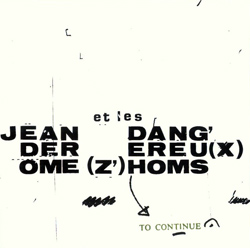
Ironic attitude with an approach to melody that is best described as angular and cubistic, but softened by a lilt of French impressionism, is what we get from the 5 improvising men that are Derome on saxes and flute, Tom Walsh on trombone, Guillaume Dostaler on piano, Pierre Cartier on electric bass, Pierre Tanguay on drums and all 5 on vocals in the title cut. (Cartier also does the singing in the fable "La Grenouille et le Boeuf").
In rendering the six Derome compositions on this disc, the quintet of Montreal voices delivers a distinct group sound. Derome, known to many in the improvised music and musique actuelle scene (he is also one of its production motors), possesses a recognizable alto saxophone voice, with its driven sense of direction and acrobatic ingenuity that is the aural equivalent of a refined circus act. He's accompanied by equally distinct voices, starting with his usual partner in musical adventure, Pierre Tanguay, a drummer who plays from simple, centered ideas that mutate into sophisticated variations. Walsh's trombone voice is rich in overtones and humor, while Cartier's electric bass stitches the tunes together with a firm sense of purpose. Pianist Dostaler leaves lots of space, which he incorporates into his conceptions, even in his featured solo spots, not unlike Monk.
There are many interesting musical moments both quirky and serene throughout the disc, including the English word-based title cut and the setting of the La Fontaine fable "La Grenouille et le Boeuf" ("The Frog and the Ox") that Cartier intones in fine-form expressionistic contortions. The best, however, is the longest: "Prières" ("Prayers"), a 25 minute piece that is a lesson in textures and the blending of voices and interweaving of the composed and the improvised. It features a piano solo accompanied by very spare band responses, then builds into a slow whirling of lines and textures that gives way to a trombone solo where Walsh gets the chance to "testify", then on to a drum solo and more building, with, from time to time, solo statements taking the upper hand. Then a return to piano solos and more development of motives wrought into the earlier exposition. A study in form, contrasts, colors, voices, lines, and harmonies at the center of which is Derome's saxophone soaring in fearless inventiveness.
Comments and Feedback:
|



